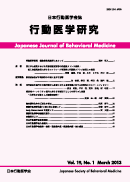All issues

Volume 19 (2013)
- Issue 2 Pages 50-
- Issue 1 Pages 3-
- Issue Supplement Page・・・
Volume 19, Issue 1
Displaying 1-4 of 4 articles from this issue
- |<
- <
- 1
- >
- >|
Original
-
Tatsuo SAIGO, Shun NAKAJIMA, Sayaka OGAWA, Jun TAYAMA2013 Volume 19 Issue 1 Pages 3-10
Published: 2013
Released on J-STAGE: July 03, 2014
JOURNAL FREE ACCESSThe purpose of this study was to determine the incidence of post-traumatic stress disorder (PTSD) in disaster medical assistance staff 1.5 months after the earthquake in east Japan, and examine the relationship between controllability for intrusions and post-traumatic stress symptoms. Our hypothesis was that high controllability for intrusions is associated with mild post-traumatic stress symptoms. To investigate this hypothesis, we determined the prevalence of PTSD and the relationships among post-traumatic stress symptoms, peri-traumatic distress, depression and controllability for intrusions in 54 disaster medical assistance staff members (DMAT team, radiation medical assistance team, mass transport team, community medicine team). The results indicated that none of the staff developed PTSD. Statistical analysis showed negative correlations between controllability for post-traumatic stress symptoms, intrusions and hyperarousal. Comparing high controllability with low controllability, we found that the severity of post-traumatic stress symptoms was higher in staff with low controllability than in those with high controllability. The results of this study suggest that high controllability for intrusion prevented post-traumatic stress symptoms.View full abstractDownload PDF (547K)
Case Report
-
Euiyeon KIM, Akira TSUDA, Shin MURATA, Satoshi HORIUCHI2013 Volume 19 Issue 1 Pages 11-16
Published: 2013
Released on J-STAGE: July 03, 2014
JOURNAL FREE ACCESSThe effects of Static Hwalmyeong training on insomnia were compared using two groups of senior citizens. Nine the Static Hwalmyeong group (median= 49.5 years) and 14 comparison group (median= 58 years) citizens participated in this study. Insomnia, as well as subjective rating of health and depression, were measured before and after a series of practicing 60 minutes the Static Hwalmyeong training once a week for four weeks. Before starting practice the Static Hwalmyeong group showed significantly higher levels of insomnia and depression as well as lower level of subjective health compared with the comparison group. After the intervention, in the Static Hwalmyeong group, the Pittsburgh Sleep Quality Index (PSQI)’s global score decreased significantly, but the scores of depression and subjective health did not change. The results suggest that Static Hwalmyeong training has the potential to decrease participant’s PSQI global scores. Thus, the training may prevent the often observed insomnia among senior citizens. However, large-scale randomized trials are needed to confirm these findings.View full abstractDownload PDF (2087K)
Report
-
Autonomy and Self-Efficacy of Physical Activity in Advanced Lung Cancer Patients during ChemotherapyKazuhiro HARADA, Kei HIRAI, Hirokazu ARAI, Akihiro TOKORO2013 Volume 19 Issue 1 Pages 17-24
Published: 2013
Released on J-STAGE: July 03, 2014
JOURNAL FREE ACCESSThe purposes of the present study were to examine whether patients who have higher autonomy and self-efficacy of physical activity were more physically active, to explore relationships between psychological adjustment and autonomy or self-efficacy, and to evaluate the role of performance status as confounder of these relationships in Japanese advanced lung cancer patients in chemotherapy. The sample was nine advanced lung cancer patients in chemotherapy with written informed consent for the enrolment of a seven-day study. Physical activity was recorded by uniaxial accelerometry (Lifecoder EX, Suzuken, Co. Ltd.) during seven days. Performance status, psychological adjustment (anxiety and depression), autonomy, and the self-efficacy of physical activity were assessed at baseline and after seven days. In patients whose performance status declined during seven days (n=4), significant correlation between anxiety and autonomy of physical activity was revealed (r=–0.97, p<0.05). Also, correlation between depression and self-efficacy of physical activity was marginally significant (r=0.93, p<0.10). On the other hand, in patients whose performance status was not changed (n=5), autonomy and self-efficacy were not significantly correlated with psychological adjustment. Finally, autonomy and self-efficacy did not significantly correlate with physical activity in either group of patients. The present study indicates that Japanese advanced lung cancer patients in chemotherapy who have the higher autonomy and the higher self-efficacy of physical activity might be more psychologically adjusted if performance status declined.View full abstractDownload PDF (634K) -
Keiichiro ADACHI, Tokumi UENO2013 Volume 19 Issue 1 Pages 25-31
Published: 2013
Released on J-STAGE: July 03, 2014
JOURNAL FREE ACCESSRecently, the number of patients with mood disorder is increasing. Although strong evidence suggests that depression is a common experience among individuals meeting criteria for borderline personality disorder, etiological findings have not been confirmed. This exploratory study is aiming to clarify relation between depression, avoidance, and borderline personality traits using covariance structure analysis with college students. As a result, depression predicts borderline personality traits mediated by avoidance and directly predicts them. However, borderline personality traits also predict depression (reversed pass model) not mediated by avoidance and fit indices for this model indicate acceptable level. In the future, further studies will be needed to reexamine this etiological model with clinical subjects.View full abstractDownload PDF (934K)
- |<
- <
- 1
- >
- >|